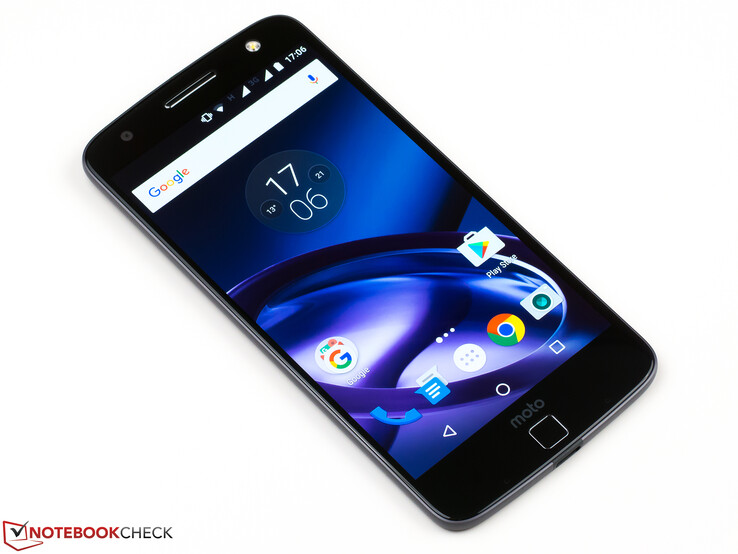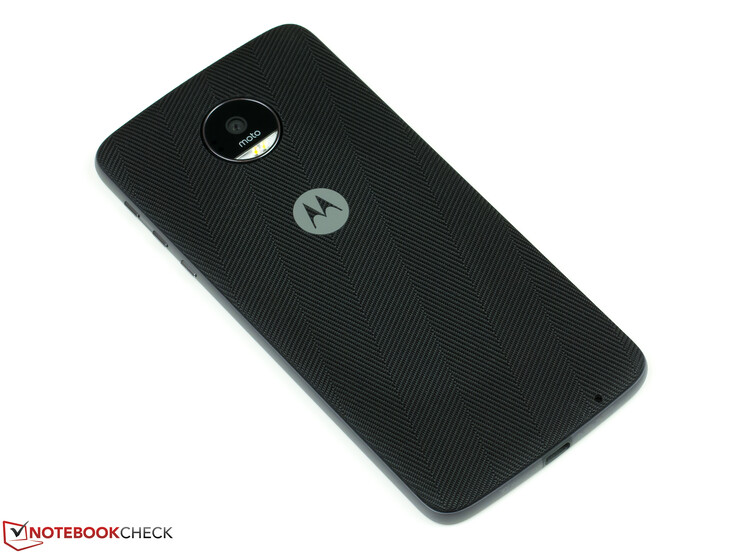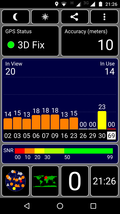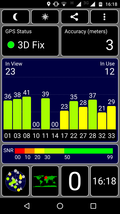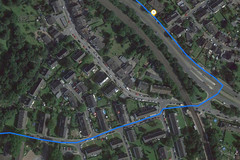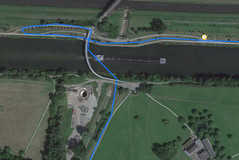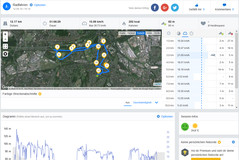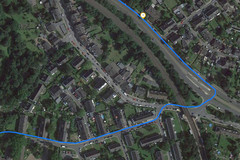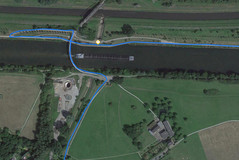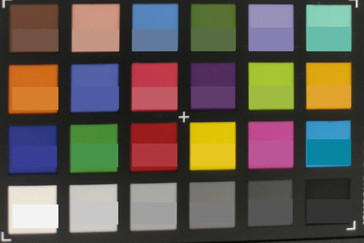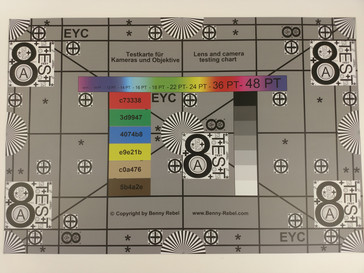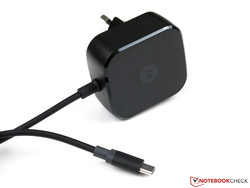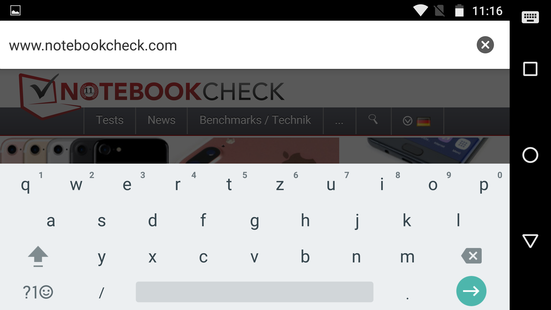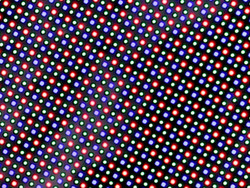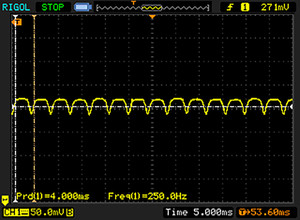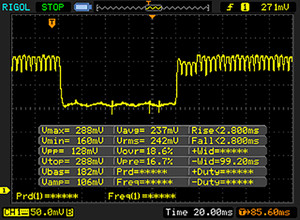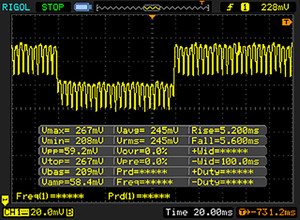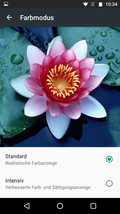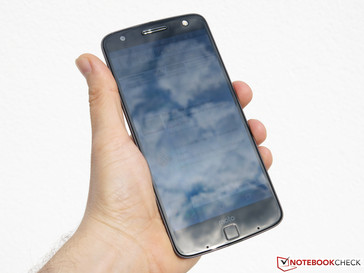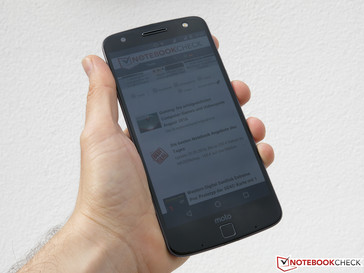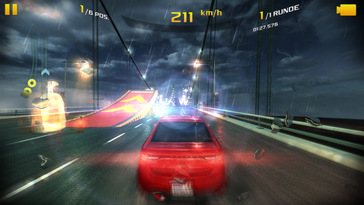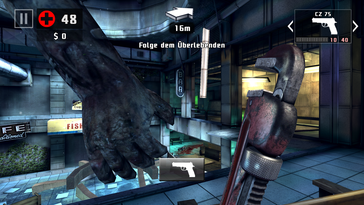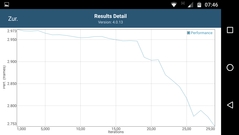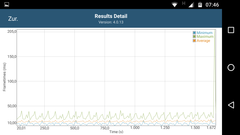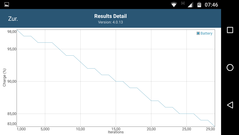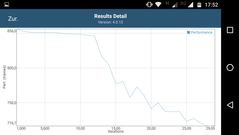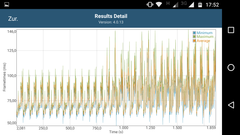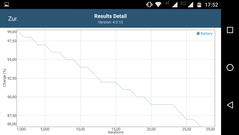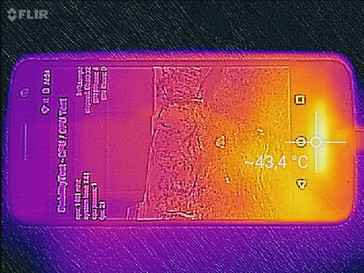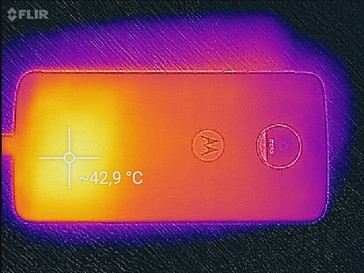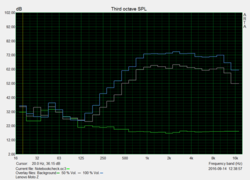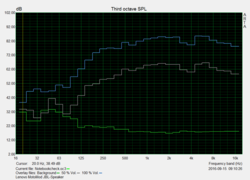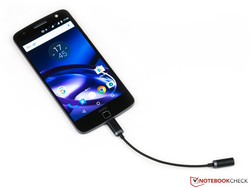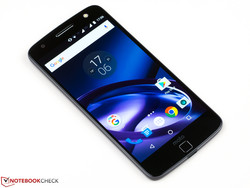Lenovo Moto Z Smartphone Review
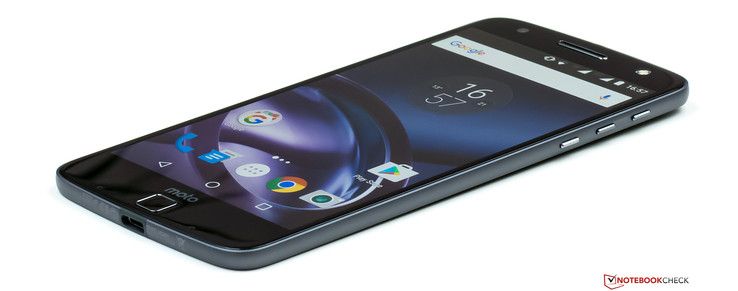
For the original German review, see here.
The Moto Z is Lenovo's new flagship smartphone. Besides the powerful technology, it aims to convince particularly, with its unconventional construction: It impresses with a very slim case, and you can also attach additional modules at the back to expand the usage scenarios of the device or create a unique look. These so called Moto Mods are also compatible with the two siblings, the Moto Z Play and the Moto Z Force, and are supposed to support at least three generations of devices. You can get the Moto Z in the colors "White & Fine Gold" as well as "Black & Lunar Grey" for a retail price of 699 Euros (~$786).
Equipped with 32 GB of internal storage, 4 GB of RAM and a Snapdragon 820 SoC, the specifications are on par with the high-end competition. The list includes Android devices such as the Samsung Galaxy S7 Edge, the LG G5, the Huawei P9 Plus, the OnePlus 3 as well as Google’s reference model Nexus 6P. The Windows based Microsoft Lumia 950 XL and Apple's brand-new iPhone 7 Plus are also suitable rivals.
Case
Thanks to the extremely slim profile of just 5.2 millimeters (~0.2 in), the case of the Moto Z is a real eye-catcher – even other very slim rivals such the Huawei P9 Plus (7 mm/~0.27 in) and the iPhone 7 Plus (7.3 mm/~0.29 in) appear comparatively thick. We have to be fair though and mention the camera bump, where the thickness is 7.3 millimeters (~0.29 in). It is also not very compact for a 5.5-inch smartphone with a width of 75.3 millimeters (~3 in) and a height of 152.7 millimeters (~6 in); the bezel underneath the display is particularly large. A weight of just 136 grams (~5 oz) is unusually light – even the LG G5 with a smaller display is noticeably heavier (+21 grams/~0.7 oz).
Despite the slim construction, we are completely convinced by the stability. Although it is possible to twist the smartphone slightly with moderate force, you can only hear minor creaking sounds. In practice, this flexibility does not affect the usability– quite the contrary: The device leaves a very robust impression despite the slim profile, which is also supported by the flawless build quality.
The Moto Z is made of airplane aluminum, stainless steel and Gorilla Glass – an appealing combination of materials. Unfortunately, the back attracts a lot of fingerprints, which is not easy to remove. The modular expandability should be the reason for the slightly rough transition between the sides and the back cover – other devices provide better ergonomics.
Connectivity
The integrated USB Type-C port of the Moto Z supports the USB 3.1 standard, so data can be transferred quickly to a PC. We saw average transfer rates of around 75 MB/s when we copied a large video file to a PC and back to the phone, which clearly exceeds the performance of devices with USB 2.0 ports. The connector also supports USB OTG. Some users will miss the usual 3.5 mm headphone jack, but at least there is a corresponding adapter in the box. Wireless connections can be established via NFC, Bluetooth 4.1 as well as Wi-Fi Direct. The wireless transfer of the display content is only possible via Chromecast, but not Miracast.
22.8 GB of the 32 GB internal storage is free out of the box. If you forgo the dual-SIM functionality, you can expand the storage via a microSD-card by up to 256 GB right now (up to 2 TB in theory). It can be formatted either as a portable or an integrated storage. The advantage of the former is that files on the card can also be used by other devices, in which case, you cannot install apps on the card.
Underneath the touchscreen is a very reliable fingerprint scanner, which is surrounded by infrared sensors on the left and right. They enable the smartphone to recognize movements without direct contact and will show the time as well as notifications on the display. This feature is handy, but cannot completely replace the missing notification LED since the information is not displayed permanently.
Moto Mods
One highlight of the Moto Z is certainly the expandability features via Moto Mods. These additional modules can be attached to the back of the smartphone. The position is secured via magnets and there are some contact points for electrical connection.
The simplest mod category is Style Shells. They do not offer any additional functionality and add some protection for the back, but their main purpose is the creation of an individual design. There are some positive effects though: For starters, the mod will compensate for the camera bump, so the stability is much better when the device is lying on flat surfaces, but the hard transition between the side frame and the rear is covered, so it is more comfortable to hold. Lenovo ships the smartphone with a black Style Shell type "Herringbone Nylon", which provides a convenient tactile feel, but not a lot of grip for the hand despite its three-dimensional surface structure. Thanks to the magnetic fixation, it is very easy to attach and remove, but the connection was not perfect and we heard a crackling sound from time to time. The box also includes a transparent edge protection, which provides additional protection and is easy to attach.
There is also a Mod if the standard smartphone speaker is too quiet or unbalanced for you: The JBL Soundboost speaker is fixed by strong magnets on the back of the Moto Z, so it is pretty much impossible to remove it accidentally. Once again, we noticed that the attached module can be moved around a bit, but it is no problem in practice. Thanks to the handy fold-out stand, you can easily place the smartphone module combination on a table. Sounds are played directly through the speaker. It comes with an additional integrated 1000 mAh battery, which can be charged either via the integrated USB Type-C port or the USB port of the smartphone when it is attached. Handy: The Moto Z shows both battery charges. The additional module will obviously affect the slim smartphone profile. With a thickness of up to 18.3 mm (~0.7 in) and a weight of around 285 grams (~10 oz), the combination is quite a lump in the pocket. We will evaluate the sound performance in the Speaker section. The module is available for a list price of 99 Euros (~$111).
The third module for our review is the Insta-Share-Projector, which is currently the most expensive mod for the Moto Z-series at 349 Euros (~$392). It tips the scale at 263 grams (~9.3 oz) and has a thickness of 16.3 millimeters (~0.63 in), so the dimensions and the weight of the smartphone-module combination beat the Soundboost speaker. The Insta-Share module also comes with its own battery (1100 mAh), which can be charged either directly at the module or via a USB port on the phone. One charge will last about 60 minutes before the smartphone battery is drained. The chassis of the Moto Mod is covered by a soft-touch finish, while the fold-out stand is made of brushed metal. You can turn the projector on by pushing the power button. While the sharpness is adjusted manually via a rotary control, the parameters for the adaptive brightness control as well as the automatic or manually adjustable keystone distortion can be controlled via the smartphone display. The picture quality is actually decent for such a small projector, but it will not be sufficient for movie enthusiasts at 854x480 pixels and up to 50 Lumen. Nevertheless, the performance is okay for occasional use such as the quick presentation of your holiday pictures. The room should be as dark as possible, because the luminance of the projector will be sufficient for larger projections in this case – Lenovo advertises a diagonal size of up to 70 inches. One practical issue could be the rather loudly spinning fan. The projector is shipped with a carrying bag for secure transports.
Besides the Moto Mods that we have tested, Lenovo also offers several Style-Shells, an additional 2200 mAh battery for 89 Euros (~$100) as well as a Camera Mod with an integrated 10x zoom for 299 Euros (~$336). However, the latter has already been criticized by some reviewers. Whether Lenovo’s modules really have an advantage over external solutions such as Bluetooth speakers or pico projectors will depend mainly on the intended scenario. The easy handling as well as the open-source interface is definitely convenient, so third-party manufacturers can develop new modules as well, which should improve the variety of the Moto Mods.
Software
As per usual for Motorola, the Moto Z is shipped with an almost standard version of Android. There are only minor adjustments, including the preloaded Moto app, which configures several comfort features such as the flashlight activation via gesture or specifically adjusted notification screens during standby. It is commendable that there are no unnecessary third-party apps.
Communication and GPS
Besides the usual GSM and 3G frequencies, the test model also supports numerous LTE bands. The maximum transfer speeds in 4G networks are up to 300 Mbps downstream and up to 50 Mbps upstream.
The Moto Z also supports 2x2 MIMO WLAN including the modern AC standard with a theoretical transfer rate of up to 866 Mbps. Our measurements with the reference router Linksys EA8500 confirms high speeds: The test model is even at the top of the comparison in the receiving test and still in a very good second position in the send test. Data connections are also possible via NFC as well as Bluetooth 4.1.
| Networking | |
| iperf Server (receive) TCP 1 m | |
| Lenovo Moto Z | |
| Apple iPhone 7 Plus | |
| LG G5 | |
| Samsung Galaxy S7 Edge | |
| OnePlus 3 | |
| Huawei P9 | |
| iperf Client (transmit) TCP 1 m | |
| Apple iPhone 7 Plus | |
| Lenovo Moto Z | |
| Samsung Galaxy S7 Edge | |
| OnePlus 3 | |
| Huawei P9 | |
| LG G5 | |
Outdoors, the Moto Z will quickly locate the position with an accuracy of 3 meters (~10 ft), but it can take slightly longer indoors. Our bicycle ride shows that the smartphone does not locate the position as often as our professional navigation device Garmin Edge 500: The Bridge area in particular shows clear deviations. However, the overall distance between the two models is just 1.8%, so the performance should still be perfectly fine for everyday navigation purposes.
Telephone and Voice Quality
Thanks to a total of four microphones, the Moto Z promises good voice quality during calls, and we can confirm this after some test calls. There is hardly any criticism during normal calls; the only minor issue is a quiet background noise at the earpiece. Our voice is very clear on the other side of the call and this hardly changes when we switch to the hands-free mode, where the sound is only slightly tinny. One positive aspect is the clear voice of the call partner via the speaker of the Moto Z, especially since the volume is more than sufficient for quieter environments. A headset is not included.
Lenovo uses the familiar Android design for the phone app. All the important features are easy to find and use. Besides favorites, you get the usual things such as a history, a numbers pad and direct access to your contacts. There is also a search bar at the top.
Cameras
The front camera of the Moto Z has a 5 MP sensor and provides decent details and usually a sufficient dynamic range. It is also possible to take Full HD videos at 30 frames per second. One highlight is the LED flash at the front, which enables better pictures in dark situations, but obviously changes the picture impression.
At the back of the smartphone is a 13 MP main camera with optical image stabilization, an f/1.8 aperture as well as a laser autofocus system. While the colors of the pictures appear very vivid thanks to the HDR mode, the Moto Z lacks sharpness when we compare the results with the high-end competition. Vegetation in particular is usually rather blurry when you look at a crop. The edges are also slightly blurry, which are often easy to see even without zooming (as in scene 2). In high-contrast areas – such as the sky you can see through the leaves – also show stronger chromatic aberrations or blooming, respectively, compared to the Huawei P9, for instance. The Moto Z takes very bright, low-light pictures with the activated HDR mode in particular, but the quality usually suffers from visible picture noise.
The main camera takes videos at a resolution of up to 2160p and 30 frames per second. You can also select 60 frames per second, but the resolution will be dropped to Full HD. The quality of the UHD videos is decent, and we like the pretty smooth picture during camera pans and the good audio quality. The image stabilization works well, so the picture is very steady, even you walk around. Only the autofocus caused some issues by refocussing the picture even though it was not necessary.
The camera app can be launched directly from the standby via a double tap on the home button. It offers an automatic as well as a manual mode, where you can adjust many parameters such as the white balance, ISO value and the focus point. There are modes for slow-motions as well as panorama. However, the latter disappoints with visible picture errors and a pretty narrow maximum camera angle.
To check the color accuracy of the Lenovo Moto Z’s main camera, we take a picture of the X-Rite ColorChecker Passport under controlled lighting conditions and compare the results with the reference colors. The picture is not edited afterwards and there is no manual white balance. While the deviations for the grayscale are comparatively low, we can clearly see deviated colors: Red colors are much darker, and the reverse applies to bright blue and green tones. We can also see that the whole picture is rather blurry.
We get information about the picture quality of the camera lens as well as the resolution of the sensor by taking a picture of our test chart under controlled lighting conditions. We can see a distinct sharpness decrease towards the two right corners – but in the center the performance is not very good since fine lines already appear blurry. That other high-end devices perform better is shown by the comparison with the smartphones Google Nexus 6P as well as Samsung Galaxy S7 Edge.
Accessories and Warranty
The Lenovo Moto Z is shipped with the usual service brochures, a card slot tool, a 15-watt power adapter (5V, 3A) with a fixed USB Type-C cable, an audio adapter with a flexible retaining strap, a Style Shell as well as a transparent plastic bumper for the metal frame of the chassis. However, a headset or a data cable are not included. We have already mentioned several Moto Mods to expand your smartphone features.
Lenovo offers only a one-year warranty for the smartphone.
Input Devices and Handling
The touchscreen of the Moto Z is made of robust Gorilla Glass 4, which provides good gliding capabilities for the fingers. The precision is also convincing, so even longer texts are no problem with the preloaded standard Android keyboard. The handling leaves a pretty smooth impression in general, which is supported by the quick reaction of the position sensor when you rotate the display. It is also handy that you can launch the voice control in standby via a predefined keyword (can be set up in the Moto App).
The physical buttons have a firm pressure point and are easy to find with the fingers, but they are not always perfectly reachable due to their position at the upper right side.
A fingerprint scanner is located beneath the display that worked very reliably during our review. Not only can it be used to unlock the device, but also to deactivate the display. You do not even have to touch the smartphone to get the current time or notifications, a gesture above the smartphone is sufficient. Thanks to the two sensors that are located on the right and left next to the fingerprint scanner – which are much more noticeable on the white version of the Moto Z – the smartphone recognizes the corresponding gesture and activates the display. This is very handy, but cannot fully compensate for the missing always-on display or a notification LED, because it is not possible to show incoming messages permanently.
Display
Thanks to a resolution of 2560x1440 on the 5.5-inch screen – hence 534 PPI – the Moto Z produces razor-sharp images. With the activated brightness sensor and a completely white picture, we can measure an average luminance of up to 490 cd/m² and the brightness distribution is still pretty even at 92%. The more realistic test with evenly distributed bright and dark picture contents (APL50) determines an even brighter picture at up to 556 cd/m². The maximum value you can reach manually is lower, at 345 cd/m². These results are not outstanding within the comparison group, but the performance is solid.
One noteworthy aspect is the PWM flickering – as with most AMOLED panels – at a frequency of 250 Hz. This is also the case for the maximum luminance. Subjectively, we mainly noticed it when the time was displayed on a black standby screen.
| |||||||||||||||||||||||||
Brightness Distribution: 92 %
Center on Battery: 485 cd/m²
Contrast: ∞:1 (Black: 0 cd/m²)
ΔE Color 2.1 | 0.5-29.43 Ø5
ΔE Greyscale 2.6 | 0.57-98 Ø5.3
100% sRGB (Argyll 1.6.3 3D)
88.14% AdobeRGB 1998 (Argyll 1.6.3 3D)
99.7% AdobeRGB 1998 (Argyll 2.2.0 3D)
100% sRGB (Argyll 2.2.0 3D)
98.4% Display P3 (Argyll 2.2.0 3D)
Gamma: 2.23
| Lenovo Moto Z AMOLED, 2560x1440, 5.50 | Samsung Galaxy S7 Edge Super AMOLED, 2560x1440, 5.50 | LG G5 IPS Quantum, 2560x1440, 5.30 | Huawei P9 Plus AMOLED, 1920x1080, 5.50 | OnePlus 3 Optic-AMOLED, 1920x1080, 5.50 | Google Nexus 6P AMOLED, 2560x1440, 5.70 | Microsoft Lumia 950 XL AMOLED, 2560x1440, 5.70 | Apple iPhone 7 Plus IPS, 1920x1080, 5.50 | |
|---|---|---|---|---|---|---|---|---|
| Screen | ||||||||
| Brightness middle | 485 | 554 14% | 784 62% | 361 -26% | 419 -14% | 363 -25% | 297 -39% | 557 15% |
| Brightness | 490 | 552 13% | 774 58% | 366 -25% | 431 -12% | 365 -26% | 297 -39% | 553 13% |
| Brightness Distribution | 92 | 96 4% | 91 -1% | 87 -5% | 84 -9% | 90 -2% | 93 1% | 97 5% |
| Black Level * | 0.43 | 0.35 | ||||||
| Colorchecker dE 2000 * | 2.1 | 1.59 24% | 6.5 -210% | 5.1 -143% | 4.1 -95% | 2.34 -11% | 2.67 -27% | 1.4 33% |
| Colorchecker dE 2000 max. * | 5.5 | 2.56 53% | 11.7 -113% | 10 -82% | 12 -118% | 3.98 28% | 3.1 44% | |
| Greyscale dE 2000 * | 2.6 | 2.01 23% | 8 -208% | 5.5 -112% | 3.3 -27% | 1.03 60% | 2.81 -8% | 1.3 50% |
| Gamma | 2.23 99% | 2.01 109% | 2.22 99% | 2.24 98% | 2.1 105% | 2.23 99% | 2.08 106% | 2.21 100% |
| CCT | 6843 95% | 6321 103% | 8699 75% | 7388 88% | 6550 99% | 6429 101% | 6379 102% | 6667 97% |
| Color Space (Percent of AdobeRGB 1998) | 88.14 | 82.12 -7% | 68.08 -23% | 89.38 1% | 66.31 -25% | 63.1 -28% | ||
| Color Space (Percent of sRGB) | 100 | 99.98 0% | 97.46 -3% | 100 0% | 99.79 0% | 99.83 0% | ||
| Contrast | 1823 | 1591 |
* ... smaller is better
Screen Flickering / PWM (Pulse-Width Modulation)
| Screen flickering / PWM detected | 250 Hz | ≤ 100 % brightness setting | |
The display backlight flickers at 250 Hz (worst case, e.g., utilizing PWM) Flickering detected at a brightness setting of 100 % and below. There should be no flickering or PWM above this brightness setting. The frequency of 250 Hz is relatively low, so sensitive users will likely notice flickering and experience eyestrain at the stated brightness setting and below. In comparison: 53 % of all tested devices do not use PWM to dim the display. If PWM was detected, an average of 17903 (minimum: 5 - maximum: 3846000) Hz was measured. | |||
Display Response Times
| ↔ Response Time Black to White | ||
|---|---|---|
| 5.6 ms ... rise ↗ and fall ↘ combined | ↗ 2.8 ms rise | |
| ↘ 2.8 ms fall | ||
| The screen shows very fast response rates in our tests and should be very well suited for fast-paced gaming. In comparison, all tested devices range from 0.1 (minimum) to 240 (maximum) ms. » 13 % of all devices are better. This means that the measured response time is better than the average of all tested devices (21.5 ms). | ||
| ↔ Response Time 50% Grey to 80% Grey | ||
| 10.8 ms ... rise ↗ and fall ↘ combined | ↗ 5.2 ms rise | |
| ↘ 5.6 ms fall | ||
| The screen shows good response rates in our tests, but may be too slow for competitive gamers. In comparison, all tested devices range from 0.2 (minimum) to 636 (maximum) ms. » 19 % of all devices are better. This means that the measured response time is better than the average of all tested devices (33.7 ms). | ||
The Moto Z has two basic color modes you can select in the settings. We can measure average DeltaE deviations compared to the sRGB reference of just 2.1 (colors) and 2.6 (grayscale) in the "Standard" mode. This is within the ideal range under 3. The color temperature is also just slightly increased at 6843 K compared to an ideal value of 6500 K. Changing to the "Intense" mode will increase the average DeltaE deviations compared to the sRGB reference to 5.9 (colors) and 4.2 (grayscale) as well as the color temperature to 7246 K – even though the average DeltaE deviations are slightly lower compared to the wider AdobeRGB color space (around 4).
The Moto Z also works pretty well outdoors, where the smartphone benefits from the high contrast of the AMOLED panel as well as the decent maximum luminance. Only direct sunlight is a challenge for the screen and you cannot see a lot of the actual content.
Performance
As it should be for a modern flagship smartphone, the Moto Z is equipped with a powerful Snapdragon 820 SoC consisting of four Kyro cores. However, instead of a maximum clock speed design of 2.2 GHz (LG G5 or OnePlus 3) the cores can only reach up to 1.8 GHz in this case. The integrated Adreno 530 GPU is also slightly slower than the mentioned rivals at 510 MHz. But what are the effects on the benchmark scores? Fortunately, we cannot see a huge difference in many tests. Our test model performs very well compared to the high-end rivals, and we can only notice a disadvantage in the Geekbench 3 and 4 Single-Core tests, where the models LG G5 and OnePlus 3 with the same SoC are about 15% faster. The Moto Z can even take the top spot among the Android competition in PCMark – overall a good performance.
| AnTuTu v6 - Total Score (sort by value) | |
| Lenovo Moto Z | |
| Samsung Galaxy S7 Edge | |
| LG G5 | |
| Huawei P9 Plus | |
| OnePlus 3 | |
| Google Nexus 6P | |
| Microsoft Lumia 950 XL | |
| Apple iPhone 7 Plus | |
| Geekbench 3 | |
| 64 Bit Multi-Core Score (sort by value) | |
| Lenovo Moto Z | |
| Samsung Galaxy S7 Edge | |
| LG G5 | |
| Huawei P9 Plus | |
| OnePlus 3 | |
| Google Nexus 6P | |
| 64 Bit Single-Core Score (sort by value) | |
| Lenovo Moto Z | |
| Samsung Galaxy S7 Edge | |
| LG G5 | |
| Huawei P9 Plus | |
| OnePlus 3 | |
| Google Nexus 6P | |
| Geekbench 4.0 | |
| Compute RenderScript Score (sort by value) | |
| Lenovo Moto Z | |
| Samsung Galaxy S7 Edge | |
| LG G5 | |
| OnePlus 3 | |
| 64 Bit Multi-Core Score (sort by value) | |
| Lenovo Moto Z | |
| Samsung Galaxy S7 Edge | |
| LG G5 | |
| OnePlus 3 | |
| Apple iPhone 7 Plus | |
| 64 Bit Single-Core Score (sort by value) | |
| Lenovo Moto Z | |
| Samsung Galaxy S7 Edge | |
| LG G5 | |
| OnePlus 3 | |
| Apple iPhone 7 Plus | |
| ANDEBench PRO | |
| 3D (sort by value) | |
| Lenovo Moto Z | |
| LG G5 | |
| OnePlus 3 | |
| Platform (sort by value) | |
| Lenovo Moto Z | |
| LG G5 | |
| OnePlus 3 | |
| Storage (sort by value) | |
| Lenovo Moto Z | |
| LG G5 | |
| OnePlus 3 | |
| Memory Latency (sort by value) | |
| Lenovo Moto Z | |
| LG G5 | |
| OnePlus 3 | |
| Memory Bandwidth (sort by value) | |
| Lenovo Moto Z | |
| LG G5 | |
| OnePlus 3 | |
| CoreMark-PRO/HPC (Base) (sort by value) | |
| Lenovo Moto Z | |
| LG G5 | |
| OnePlus 3 | |
| Device Score (sort by value) | |
| Lenovo Moto Z | |
| LG G5 | |
| OnePlus 3 | |
| PCMark for Android - Work performance score (sort by value) | |
| Lenovo Moto Z | |
| Samsung Galaxy S7 Edge | |
| LG G5 | |
| Huawei P9 Plus | |
| OnePlus 3 | |
| Google Nexus 6P | |
| Basemark ES 3.1 / Metal - offscreen Overall Score (sort by value) | |
| Lenovo Moto Z | |
| Samsung Galaxy S7 Edge | |
| LG G5 | |
| OnePlus 3 | |
| Apple iPhone 7 Plus | |
| GFXBench (DX / GLBenchmark) 2.7 | |
| T-Rex Onscreen (sort by value) | |
| Lenovo Moto Z | |
| Samsung Galaxy S7 Edge | |
| LG G5 | |
| Huawei P9 Plus | |
| OnePlus 3 | |
| Google Nexus 6P | |
| Microsoft Lumia 950 XL | |
| Apple iPhone 7 Plus | |
| 1920x1080 T-Rex Offscreen (sort by value) | |
| Lenovo Moto Z | |
| Samsung Galaxy S7 Edge | |
| LG G5 | |
| Huawei P9 Plus | |
| OnePlus 3 | |
| Google Nexus 6P | |
| Microsoft Lumia 950 XL | |
| Apple iPhone 7 Plus | |
| GFXBench 3.0 | |
| 1920x1080 1080p Manhattan Offscreen (sort by value) | |
| Lenovo Moto Z | |
| Samsung Galaxy S7 Edge | |
| LG G5 | |
| Huawei P9 Plus | |
| OnePlus 3 | |
| Google Nexus 6P | |
| Microsoft Lumia 950 XL | |
| Apple iPhone 7 Plus | |
| on screen Manhattan Onscreen OGL (sort by value) | |
| Lenovo Moto Z | |
| Samsung Galaxy S7 Edge | |
| LG G5 | |
| Huawei P9 Plus | |
| OnePlus 3 | |
| Google Nexus 6P | |
| Microsoft Lumia 950 XL | |
| Apple iPhone 7 Plus | |
| GFXBench 3.1 | |
| 1920x1080 Manhattan ES 3.1 Offscreen (sort by value) | |
| Lenovo Moto Z | |
| Samsung Galaxy S7 Edge | |
| LG G5 | |
| Huawei P9 Plus | |
| OnePlus 3 | |
| Google Nexus 6P | |
| Apple iPhone 7 Plus | |
| on screen Manhattan ES 3.1 Onscreen (sort by value) | |
| Lenovo Moto Z | |
| Samsung Galaxy S7 Edge | |
| LG G5 | |
| Huawei P9 Plus | |
| OnePlus 3 | |
| Google Nexus 6P | |
| Apple iPhone 7 Plus | |
| GFXBench | |
| 1920x1080 Car Chase Offscreen (sort by value) | |
| Lenovo Moto Z | |
| Samsung Galaxy S7 Edge | |
| LG G5 | |
| Huawei P9 Plus | |
| OnePlus 3 | |
| on screen Car Chase Onscreen (sort by value) | |
| Lenovo Moto Z | |
| Samsung Galaxy S7 Edge | |
| LG G5 | |
| Huawei P9 Plus | |
| OnePlus 3 | |
| 3DMark | |
| 1280x720 offscreen Ice Storm Unlimited Score (sort by value) | |
| Lenovo Moto Z | |
| Samsung Galaxy S7 Edge | |
| LG G5 | |
| Huawei P9 Plus | |
| OnePlus 3 | |
| Google Nexus 6P | |
| Apple iPhone 7 Plus | |
| 1280x720 offscreen Ice Storm Unlimited Graphics Score (sort by value) | |
| Lenovo Moto Z | |
| Samsung Galaxy S7 Edge | |
| LG G5 | |
| Huawei P9 Plus | |
| OnePlus 3 | |
| Google Nexus 6P | |
| Apple iPhone 7 Plus | |
| 1280x720 offscreen Ice Storm Unlimited Physics (sort by value) | |
| Lenovo Moto Z | |
| Samsung Galaxy S7 Edge | |
| LG G5 | |
| Huawei P9 Plus | |
| OnePlus 3 | |
| Google Nexus 6P | |
| Apple iPhone 7 Plus | |
| 2560x1440 Sling Shot OpenGL ES 3.0 Physics (sort by value) | |
| Lenovo Moto Z | |
| Samsung Galaxy S7 Edge | |
| LG G5 | |
| Huawei P9 Plus | |
| OnePlus 3 | |
| Google Nexus 6P | |
| Apple iPhone 7 Plus | |
| 2560x1440 Sling Shot OpenGL ES 3.0 Graphics (sort by value) | |
| Lenovo Moto Z | |
| Samsung Galaxy S7 Edge | |
| LG G5 | |
| Huawei P9 Plus | |
| OnePlus 3 | |
| Google Nexus 6P | |
| Apple iPhone 7 Plus | |
| 2560x1440 Sling Shot OpenGL ES 3.0 (sort by value) | |
| Lenovo Moto Z | |
| Samsung Galaxy S7 Edge | |
| LG G5 | |
| Huawei P9 Plus | |
| OnePlus 3 | |
| Google Nexus 6P | |
| Apple iPhone 7 Plus | |
| Lightmark - 1920x1080 1080p (sort by value) | |
| Lenovo Moto Z | |
| Samsung Galaxy S7 Edge | |
| LG G5 | |
| OnePlus 3 | |
| Epic Citadel - Ultra High Quality (sort by value) | |
| Lenovo Moto Z | |
| Samsung Galaxy S7 Edge | |
| LG G5 | |
| OnePlus 3 | |
| Basemark X 1.1 | |
| High Quality (sort by value) | |
| Lenovo Moto Z | |
| Samsung Galaxy S7 Edge | |
| LG G5 | |
| OnePlus 3 | |
| Medium Quality (sort by value) | |
| Lenovo Moto Z | |
| Samsung Galaxy S7 Edge | |
| LG G5 | |
| OnePlus 3 | |
| Microsoft Lumia 950 XL | |
Unfortunately, the Moto Z is not convincing in the browser benchmarks: While it is average in the BaseMark OS II Web test as well as Mozilla’s Kraken 1.1 benchmark, it falls behind in the other tests. Subjectively, there are no performance issues since even complex websites are quickly loaded.
| Mozilla Kraken 1.1 - Total (sort by value) | |
| Lenovo Moto Z | |
| Samsung Galaxy S7 Edge | |
| LG G5 | |
| Huawei P9 Plus | |
| OnePlus 3 | |
| Google Nexus 6P | |
| Microsoft Lumia 950 XL | |
| Apple iPhone 7 Plus | |
| Octane V2 - Total Score (sort by value) | |
| Lenovo Moto Z | |
| Samsung Galaxy S7 Edge | |
| LG G5 | |
| Huawei P9 Plus | |
| OnePlus 3 | |
| Google Nexus 6P | |
| Microsoft Lumia 950 XL | |
| Apple iPhone 7 Plus | |
| WebXPRT 2015 - Overall (sort by value) | |
| Lenovo Moto Z | |
| Samsung Galaxy S7 Edge | |
| LG G5 | |
| Huawei P9 Plus | |
| OnePlus 3 | |
| Google Nexus 6P | |
| Microsoft Lumia 950 XL | |
| Apple iPhone 7 Plus | |
| JetStream 1.1 - Total Score (sort by value) | |
| Lenovo Moto Z | |
| Samsung Galaxy S7 Edge | |
| LG G5 | |
| Huawei P9 Plus | |
| OnePlus 3 | |
| Google Nexus 6P | |
| Microsoft Lumia 950 XL | |
| Apple iPhone 7 Plus | |
| Vellamo 3.x - Browser (sort by value) | |
| Lenovo Moto Z | |
| Samsung Galaxy S7 Edge | |
| LG G5 | |
| OnePlus 3 | |
| BaseMark OS II - Web (sort by value) | |
| Lenovo Moto Z | |
| Samsung Galaxy S7 Edge | |
| LG G5 | |
| Huawei P9 Plus | |
| OnePlus 3 | |
| Google Nexus 6P | |
| Microsoft Lumia 950 XL | |
| Apple iPhone 7 Plus | |
* ... smaller is better
Lenovo has not economized in terms of internal storage of the Moto Z: At 74.93 MB/s, it is particularly fast with random writes – but the Lenovo also manages good results in the other tests. Samsung's Galaxy S7 Edge is still ahead when we look at sequential read transfers, but it is otherwise beaten by our test model. The situation is the same for the microSD-slot: We measured 45.64 (write) and 78.51 MB/s (read) in combination with our reference card Toshiba Exceria Pro M401 (THN-M401S0640E2, UHS-I Class 3, read up to 95 MB/s, write up to 80 MB/s). Both results are good and can actually meet the expectations for a high-end device, even though the memory card would support even higher transfer rates.
| AndroBench 3-5 | |
| Random Read 4KB (sort by value) | |
| Lenovo Moto Z | |
| Samsung Galaxy S7 Edge | |
| LG G5 | |
| Huawei P9 Plus | |
| OnePlus 3 | |
| Google Nexus 6P | |
| Random Write 4KB (sort by value) | |
| Lenovo Moto Z | |
| Samsung Galaxy S7 Edge | |
| LG G5 | |
| Huawei P9 Plus | |
| OnePlus 3 | |
| Google Nexus 6P | |
| Sequential Write 256KB (sort by value) | |
| Lenovo Moto Z | |
| Samsung Galaxy S7 Edge | |
| LG G5 | |
| Huawei P9 Plus | |
| OnePlus 3 | |
| Google Nexus 6P | |
| Sequential Read 256KB (sort by value) | |
| Lenovo Moto Z | |
| Samsung Galaxy S7 Edge | |
| LG G5 | |
| Huawei P9 Plus | |
| OnePlus 3 | |
| Google Nexus 6P | |
| Sequential Write 256KB SDCard (sort by value) | |
| Lenovo Moto Z | |
| Samsung Galaxy S7 Edge | |
| LG G5 | |
| Huawei P9 Plus | |
| Sequential Read 256KB SDCard (sort by value) | |
| Lenovo Moto Z | |
| Samsung Galaxy S7 Edge | |
| LG G5 | |
| Huawei P9 Plus | |
| BaseMark OS II - Memory (sort by value) | |
| Lenovo Moto Z | |
| Samsung Galaxy S7 Edge | |
| LG G5 | |
| Huawei P9 Plus | |
| OnePlus 3 | |
| Google Nexus 6P | |
| Microsoft Lumia 950 XL | |
| Apple iPhone 7 Plus | |
Games
Thanks to the powerful Adreno 530 graphics, even the high resolution of the Moto Z (2560x1440 pixels) is no problem when you want to play games. Even very complex games such as “Asphalt 8” or “Dead Trigger 2” are running – as expected – completely smoothly on the test model. “Asphalt 8” obviously has an FPS limit, because all settings top out at 29 frames per second.
Both the touchscreen as well as the integrated position sensors work very reliably while gaming. Another positive aspect is the position of the speaker at the front, because you can hardly cover it accidentally when you play games.
| Asphalt 8: Airborne | |||
| Settings | Value | ||
| high | 29 fps | ||
| very low | 29 fps | ||
| Dead Trigger 2 | |||
| Settings | Value | ||
| high | 60 fps | ||
Emissions
Temperature
Considering the slim construction of the Moto Z, you might think that the surface temperatures would take a hit. At up to 42.2 °C (~108 °F), however, they are in the standard range for a powerful smartphone, and the subjective heat development is not too high under sustained loads either. The increased idle temperatures of up to 36 °C (~97 °F) at some spots is hardly noticeable, but measurable.
Are these temperatures the result of a throttling SoC under sustained loads? We use the two GFXBench Battery Tests to answer this question. The T-Rex test showed a performance drop of around 7.4% after 18 iterations – Samsung's Galaxy S7 Edge reduced the comparable initial performance by up to 54%. The more demanding Manhattan benchmarks caused a greater drop by 16.2% after 12 iterations, but some rivals with the Snapdragon 820 SoC are worse: The performance of the LG G5, for example, was reduced by up to 30%. However, the initial performance was higher, so the test model is roughly on par after some test runs, despite the lower throttling percentage. The OnePlus 3 does not have such problems, and its Snapdragon SoC can always maintain the full potential.
(±) The maximum temperature on the upper side is 42.4 °C / 108 F, compared to the average of 35 °C / 95 F, ranging from 21.9 to 56 °C for the class Smartphone.
(±) The bottom heats up to a maximum of 40.6 °C / 105 F, compared to the average of 33.8 °C / 93 F
(±) In idle usage, the average temperature for the upper side is 32.8 °C / 91 F, compared to the device average of 32.7 °C / 91 F.
Speakers
The mono speaker of the Moto Z is located behind the opening of the ear piece and therefore projects the sound directly towards the user. At up to 83.9 dB(A), it is not quite as loud as the modules in the rivals LG G5 and OnePlus 3, but the performance is still sufficient in many cases thanks to its good position. The sound quality is decent for a smartphone and there are no annoying distortions even at higher volumes. Bass is, as usual, not really powerful, and this is actually one area where the additional JBL Soundboost speaker (also see chapter Moto Mods) comes into play. It can be attached to the back of the smartphone via magnets and immediately handles the audio output. At up to 95.2 dB(A), it is much louder than the internal speaker and covers the deep frequencies much better. Our measurements also show a much wider frequency response, which results in a subjectively richer sound.
Since the Moto Z has dispensed with a standard 3.5 mm headphone jack, you have to rely on the provided adapter when you want to use your usual headphones. Subjectively, the sound quality via adapter is mostly flawless, but we sometimes noticed small interferences. They happened when we pushed the Home button shortly after the audio playback stopped, for example. The adapter blocks the USB port, so you cannot charge the battery while you listen to music.
Lenovo Moto Z audio analysis
(+) | speakers can play relatively loud (83.9 dB)
Bass 100 - 315 Hz
(-) | nearly no bass - on average 34.4% lower than median
(±) | linearity of bass is average (8.2% delta to prev. frequency)
Mids 400 - 2000 Hz
(±) | reduced mids - on average 5.4% lower than median
(+) | mids are linear (6% delta to prev. frequency)
Highs 2 - 16 kHz
(+) | balanced highs - only 2.3% away from median
(+) | highs are linear (1.8% delta to prev. frequency)
Overall 100 - 16.000 Hz
(±) | linearity of overall sound is average (23.5% difference to median)
Compared to same class
» 47% of all tested devices in this class were better, 9% similar, 45% worse
» The best had a delta of 12%, average was 38%, worst was 134%
Compared to all devices tested
» 66% of all tested devices were better, 7% similar, 28% worse
» The best had a delta of 4%, average was 25%, worst was 134%
no name audio analysis
(+) | speakers can play relatively loud (95.2 dB)
Bass 100 - 315 Hz
(±) | reduced bass - on average 11.6% lower than median
(±) | linearity of bass is average (7.4% delta to prev. frequency)
Mids 400 - 2000 Hz
(+) | balanced mids - only 2.7% away from median
(+) | mids are linear (2.6% delta to prev. frequency)
Highs 2 - 16 kHz
(+) | balanced highs - only 2.4% away from median
(+) | highs are linear (3.8% delta to prev. frequency)
Overall 100 - 16.000 Hz
(+) | overall sound is linear (10.5% difference to median)
Compared to same class
» 4% of all tested devices in this class were better, 1% similar, 95% worse
» The best had a delta of 4%, average was 25%, worst was 134%
Compared to all devices tested
» 4% of all tested devices were better, 1% similar, 95% worse
» The best had a delta of 4%, average was 25%, worst was 134%
LG G5 audio analysis
(+) | speakers can play relatively loud (86.4 dB)
Bass 100 - 315 Hz
(-) | nearly no bass - on average 28.3% lower than median
(±) | linearity of bass is average (12.5% delta to prev. frequency)
Mids 400 - 2000 Hz
(+) | balanced mids - only 3.6% away from median
(+) | mids are linear (4.3% delta to prev. frequency)
Highs 2 - 16 kHz
(+) | balanced highs - only 3.8% away from median
(+) | highs are linear (1.9% delta to prev. frequency)
Overall 100 - 16.000 Hz
(±) | linearity of overall sound is average (18.8% difference to median)
Compared to same class
» 16% of all tested devices in this class were better, 9% similar, 75% worse
» The best had a delta of 12%, average was 38%, worst was 134%
Compared to all devices tested
» 38% of all tested devices were better, 8% similar, 54% worse
» The best had a delta of 4%, average was 25%, worst was 134%
Frequency Comparison (Checkboxes select/deselectable!)
Energy Management
Power Consumption
Lenovo has done a good job in terms of power consumption: The Moto Z is the most power efficient smartphone (on average) within this comparison group – only the Samsung Galaxy S7 Edge and the Huawei P9 Plus consume less power under maximum load.
| Off / Standby | |
| Idle | |
| Load |
|
| Lenovo Moto Z 2600 mAh | Samsung Galaxy S7 Edge 3600 mAh | LG G5 2800 mAh | Huawei P9 Plus 3400 mAh | OnePlus 3 3000 mAh | Google Nexus 6P 3450 mAh | Microsoft Lumia 950 XL 3340 mAh | Apple iPhone 7 Plus 2915 mAh | |
|---|---|---|---|---|---|---|---|---|
| Power Consumption | -15% | -38% | -11% | -22% | -29% | -172% | -49% | |
| Idle Minimum * | 0.66 | 0.63 5% | 0.55 17% | 0.87 -32% | 0.57 14% | 0.83 -26% | 2.85 -332% | 0.77 -17% |
| Idle Average * | 1.01 | 1.1 -9% | 1.37 -36% | 1.2 -19% | 1.24 -23% | 1.09 -8% | 2.95 -192% | 2.04 -102% |
| Idle Maximum * | 1.09 | 1.56 -43% | 2.25 -106% | 1.27 -17% | 1.36 -25% | 1.17 -7% | 3.26 -199% | 2.24 -106% |
| Load Average * | 3.97 | 5.95 -50% | 6.24 -57% | 4.69 -18% | 5.92 -49% | 7.49 -89% | 8.92 -125% | 4.69 -18% |
| Load Maximum * | 8.34 | 6.7 20% | 9.12 -9% | 5.63 32% | 10.53 -26% | 9.51 -14% | 9.39 -13% | 8.66 -4% |
* ... smaller is better
Battery Runtime
Because of the comparatively small integrated 2600 mAh battery, we do not expect new runtime records. Thanks to the efficient power consumption, however, the results are still decent: The practical WLAN test determines 6 hours and 47 minutes, which is far from the top models Samsung Galaxy S7 Edge and OnePlus 3, but it can compete with other high-end smartphones such as the LG G5, the Google Nexus 6P or the Microsoft Lumia 950 XL. The situation is similar in the video test, where our sample video runs for 12 hours and 4 minutes on the Moto Z – an average result within the high-end competition. The test model even lasted 5 hours and 20 minutes under maximum load, which is only beaten by the Samsung Galaxy S7 Edge. We can notice the smaller battery while idling though: 22 hours and 51 minutes are beaten by most rivals.
It is possible to increase the battery runtimes with the standard power-saver mode from Android Marshmallow. It limits the background activities of apps, deactivates the vibration alarm and reduces the performance of the smartphone. It can be activated either manually or automatically at predefined battery limits.
Thanks to the powerful PSU, the battery of the Moto Z is fully charged after just 1 hour and 15 minutes, and 30% are filled after 15 minutes.
| Lenovo Moto Z 2600 mAh | Samsung Galaxy S7 Edge 3600 mAh | LG G5 2800 mAh | Huawei P9 Plus 3400 mAh | OnePlus 3 3000 mAh | Google Nexus 6P 3450 mAh | Microsoft Lumia 950 XL 3340 mAh | Apple iPhone 7 Plus 2915 mAh | |
|---|---|---|---|---|---|---|---|---|
| Battery Runtime | 38% | -1% | 6% | 26% | -10% | -23% | 15% | |
| Reader / Idle | 1371 | 1663 21% | 1833 34% | 1446 5% | 1338 -2% | 1447 6% | 1078 -21% | 1835 34% |
| H.264 | 724 | 914 26% | 600 -17% | 776 7% | 847 17% | 533 -26% | 611 -16% | 813 12% |
| WiFi v1.3 | 407 | 732 80% | 387 -5% | 530 30% | 840 106% | 375 -8% | 369 -9% | 587 44% |
| Load | 320 | 392 23% | 267 -17% | 263 -18% | 268 -16% | 280 -12% | 179 -44% | 225 -30% |
Pros
Cons
Verdict
Lenovo's new flagship phone Moto Z primarily stands out from the rivals with its modular expandability. These so called Moto Mods introduce new features, which are usually not available for a smartphone. One obstacle could be the pretty high prices of the modules, but Lenovo does promise to support at least three generations of devices, so such a mod might make sense in the long run.
But the Moto Z is a successful smartphone even without the purchase of additional modules and does not have to hide behind the high-end competition: The sophisticated and extremely slim chassis as well as the powerful components can justify the premium price. And the mostly standard Android user interface should have many fans as well. We are also surprised by the decent runtimes in practice, despite the small battery.
We do not really understand why Lenovo ships the Moto Z with only an average camera though – the 21 MP sensor of the sibling Moto Z Force would have been a good addition here as well. Some potential buyers might also miss the 3.5 mm headphone jack, even though the smartphone is shipped with a corresponding adapter.
Thanks to the new Moto Mod concept, there is some fresh wind in the high-end smartphone segment. But the Moto Z also convinces with classic smartphone features. Only the picture quality of the main camera falls behind the high-end rivals.
If you like the idea of modular smartphone concepts, you should also have a look at the LG G5 before you buy the Moto Z. The LG does not have as many expansions and the handling is not quite as comfortable, but the price of the smartphone has already dropped to around 450 Euros (~$506) despite the premium hardware – and is therefore much cheaper than the test model.
Lenovo Moto Z
-
09/26/2016 v5.1(old)
Andreas Kilian


 Deutsch
Deutsch English
English Español
Español Français
Français Italiano
Italiano Nederlands
Nederlands Polski
Polski Português
Português Русский
Русский Türkçe
Türkçe Svenska
Svenska Chinese
Chinese Magyar
Magyar